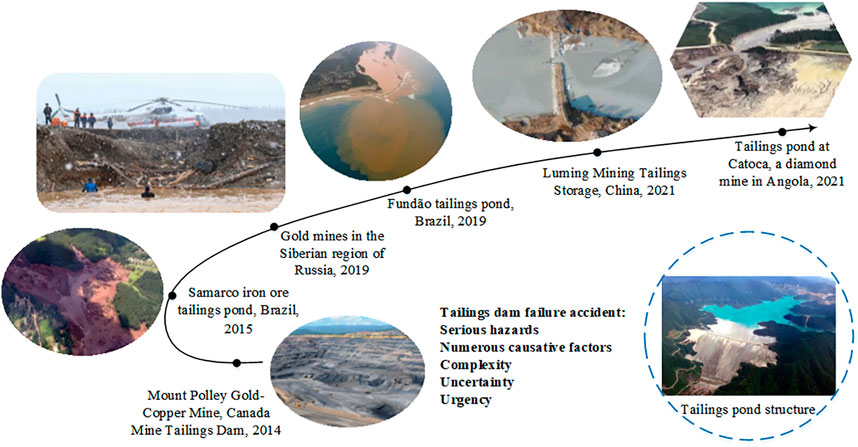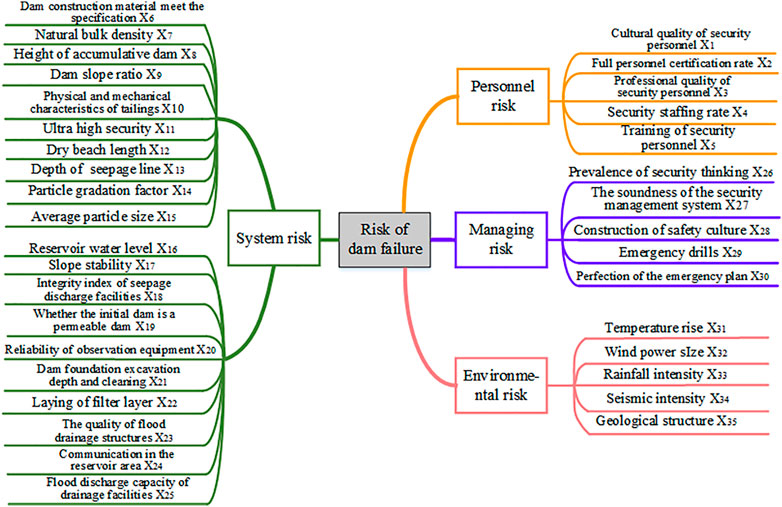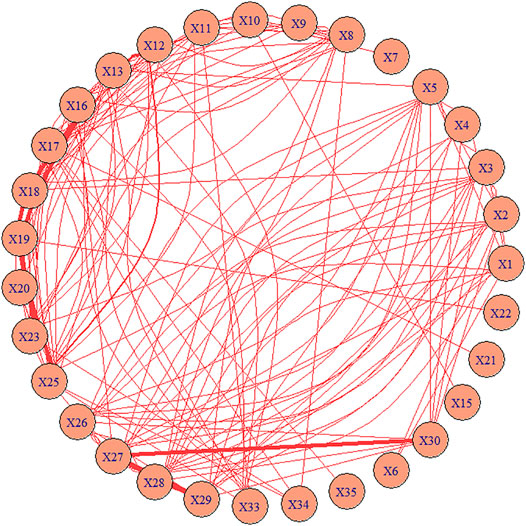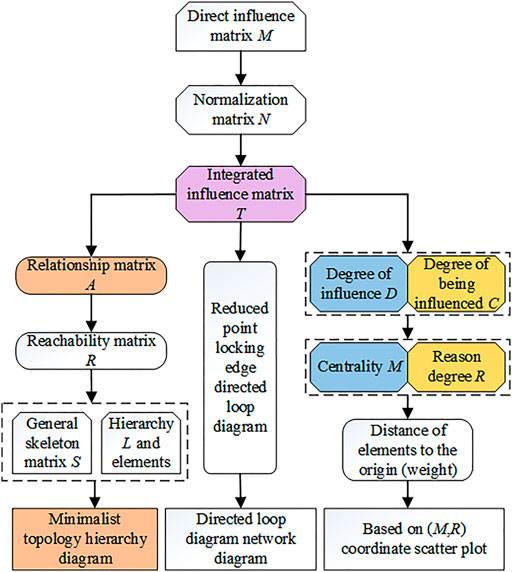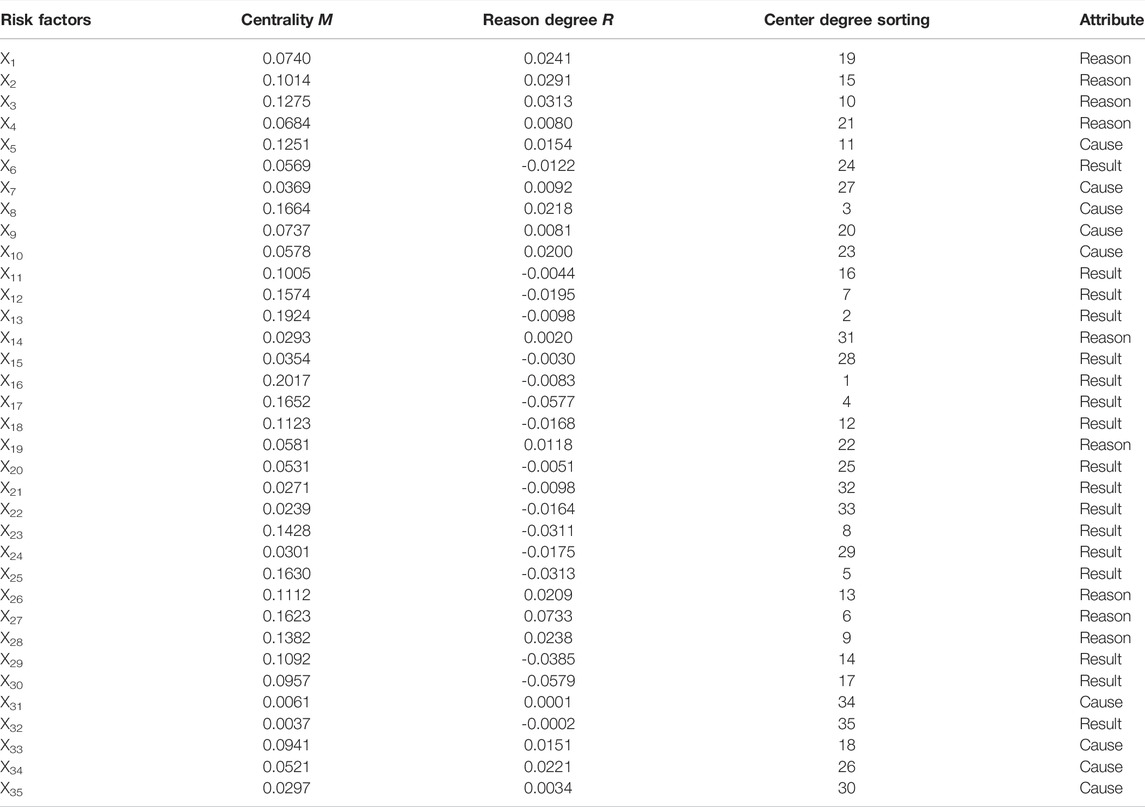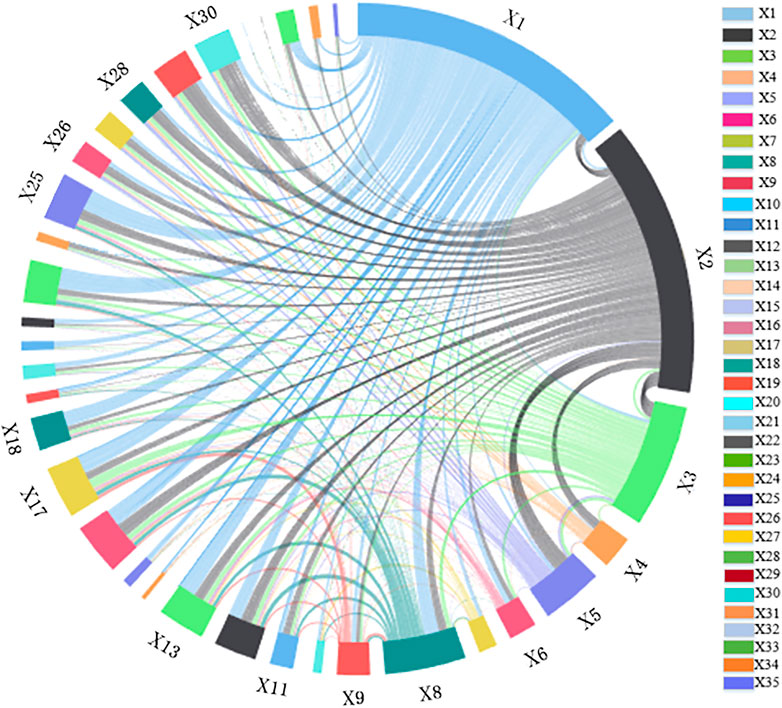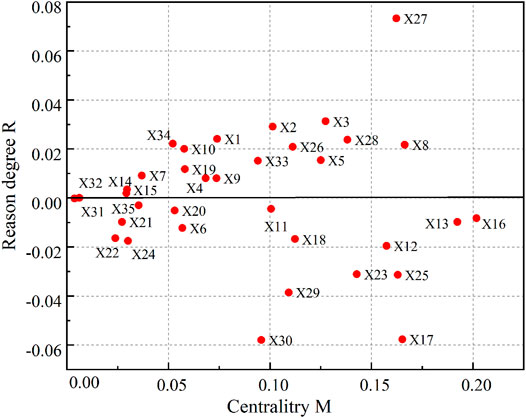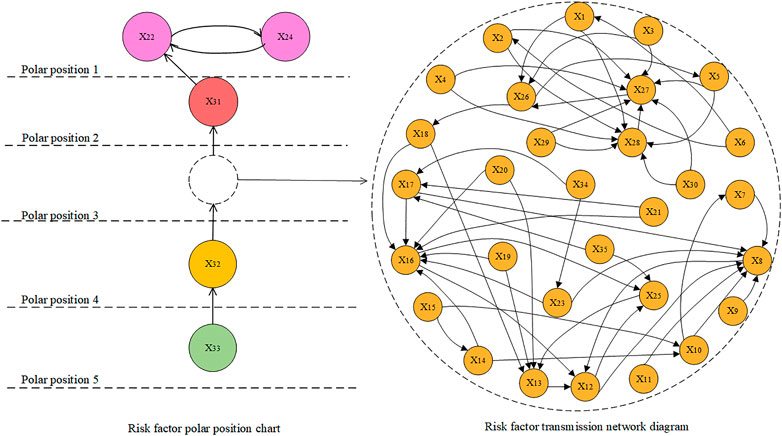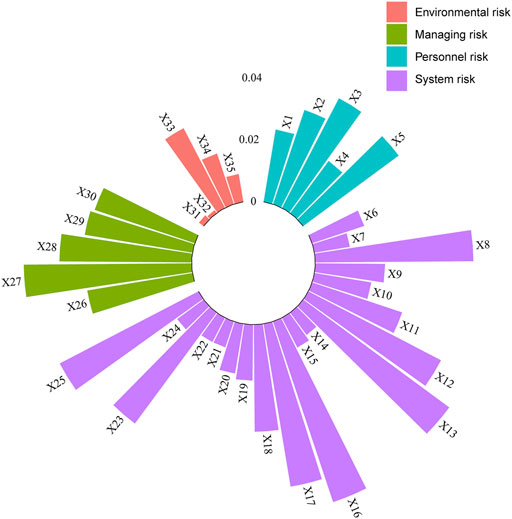- 1School of Management Science and Engineering, Shandong Technology and Business University, Yantai, China
- 2Shandong Emergency Management Institute, Shandong Technology and Business University, Yantai, China
- 3State Key Laboratory of Geohazard Prevention and Geoenvironment Protection, Chengdu University of Technology, Chengdu, China
- 4Zijin Mining Company Limited, Shanghai, China
Tailings pond engineering is a complex and extensive system with many risk factors that can trigger a dam failure. It is important to clarify the evolutionary relationships among the factors and to enhance effective management to reduce the risk of dam failure. In this paper, an effective and reliable method for analyzing the evolution of tailings pond dam failure risk by combining DEMATEL and MISM is proposed. Firstly, 35 risk factors affecting tailings pond failure were summarized. An index system for evaluating the imfluence factors of dam failure was constructed from four aspects: personnel, management, environment, and system. Secondly, the Decision-making Trial and Evaluation Laboratory (DEMATEL) was used to study the influence relationships among the factors, for analyzing and identifying the key causal factors. Subsequently, the Modified Interpretative Structural Model Method (MISM) was used to classify the cause factors into five levels of influence as well as to determine the degree of integrated influence between the risk factors. Finally, an evolutionary model of tailings pond dam failure risk was constructed based on the results of the analysis. The results of the study indicated the followings: 1) System risk accounted for 58.58% of the total weight, while personnel risk accounts for 15.51%. To maintain the stability of the tailings pond system, personnel risk should not be neglected in addition to focusing on systemic factors. 2) Rainfall intensity was an essential causal factor. Focusing on rainfall intensity and taking appropriate measures effectively reduced the risk of dam failure. The height of the dam and the depth of the seepage line accounted for a large proportion of the causal factors, making it possible to control the height of the dam and accurately monitor the depth of the seepage line to improve the stability of the dam. 3) In the tailings pond dam risk evolution model, there were 30 factors with higher mutability and correlation, which played a transitional role in risk transfer. A risk factor transfer network diagram was established for this purpose as a diagnostic map. The research results can provide new methods and ideas for tailings dam failure risk analysis research and practice.
Introduction
A tailings pond is an artificial mudflow hazard source with high potential energy. Its operation directly affected both the life and property safety of mining enterprises and the downstream public (Yang et al., 2019; Zheng et al., 2021; Wang et al., 2022). More than 8,000 tailings were currently located in China. Of these, 16% were residents or important facilities within 1 km distance downstream, which were highly susceptible to serious safety accidents, major environmental emergencies with mass incidents, which seriously threatened the safety of personnel lives as well as property and social harmony (Wang et al., 2018). The high frequency of accidents and the serious consequences has drawn the high attention of government and mining companies. In addition, as safety, reliability and automation of modern tailings pond systems have increased, its concealment and coupling increases as well. (Cao et al., 2019; Wilson et al., 2021). As the increase in system complexity leads to the transformation of the nature of the accident, the various potential interactions within the system become equally complex. Therefore, it is important to comprehensively analyze the evolution of tailings dam failure risk, clarify the interrelationships among risk factors and the degree of influence, as well as to identify key risk factors for tailings dam failure control.
The identification of hazards and the determination of their characteristics are important part of system safety management (Zhen et al., 2022). It not only defines the scope of research for subsequent accident analysis and prevention, and post-disaster rescue, but also provides a decision basis for managers. Tailings ponds are risky system projects with numerous risk factors that induce failure and increasingly sophisticated risk analysis methods. There are various methods and models commonly used for risk analysis, such as the physical modeling method (Yin et al., 2011; Nie et al., 2017), factor analysis method (Xin et al., 2011), laboratory experiment method (Xu and Wang, 2015), evaluation model method (Mei and Wu, 2012), etc. In order to reveal on the mechanism of dam failure, Marti et al. (2021) studied the mechanism and causes of the sudden collapse of the Aznalcollar tailings pond and the results indicated progressive damage, which was caused by the brittle reaction of the clay and the high pore pressure left by the incomplete consolidation of the dam foundation. Salgueiro et al. (2008) evaluated the risk of tailings dam failure based one-FonRisk combined with relevant data. Based on GIS, combined with ARIMA and 3S (RS, GIS, GPS) technologies, Nie et al. (2022) developed a 3D tailings dam visualization and early warning system to achieve high-precision prediction and real-time warning of disasters. The safety of tailings ponds was systematically studied in terms of their material properties, failure, environmental impacts and the rehabilitation of tailings pond after a dam failure by Kossoff et al. (2014). Nevertheless, the current risk analysis of tailings pond has mainly focused on single factors or the lack of correlation between multiple factors. It has been proven that tailings dam failure was a complex multi-factor coupled evolutionary process. Thus, the analysis requires consideration of the integrated influence relationship among the factors together with the risk evolution process, followed by effective risk control.
In the field of complex systems, research has gradually begun to consider the interrelationships among the factors and their impact on system stability. Meng et al. (2019) used an integrated approach of the Decision-making Trial and Evaluation Laboratory (DEMATEL) and Bayesian networks (BN) to analyze the vulnerability risk of dynamic evolution of offshore platforms, effectively identifying the root causes of chain fire and explosion accidents. Fazli et al. (2015) used the DEMATEL method to identify supply chain risk interdependencies for crude oil. The analytical network process (ANP) approach was then applied to assess the importance of each risk and identify the best response strategy. Soner (2021) combined fuzzy sets and the DEMATEL method to analyze accidents in confined spaces onboard ships. DEMATEL and the Technique for Order Preference by Similarity to an Ideal Solution (TOPSIS) models were constructed by Li et al. (2022) to prioritize and calculate risk values for hydrogen production units to identify, assess and manage vulnerabilities in hydrogen production units. Effective tools for risk assessment and management of hydrogen were production units. Risks are prioritized using the DEMATEL method by Zhang et al. (2019). An analysis of their interdependencies is then carried out to identify key risks. The DEMATEL research methodology can be used to construct a structural model involving the causal relationships of complex factors, has proven to be an effective tool that can be used to recognize the interdependences among the elements of a system and identify the critical elements.
The structure of the tailings pond is sophisticated and the risk is not significantly transmitted in the factors that trigger dam failure (Zhong et al., 2021). Consequently, it was urgent to study the risk of tailings dam failure from the perspective of complex systems theory. In this paper, the DEMATEL method was used to analyze and collate the importance of 35 risk factors. Considering that the classical Interpretative Structural Model (ISM) method has relatively complicated calculations when the amount of data is large, we used the cause-effect extraction method to improve it to suit the analysis of tailings pond risk evolution. The cause-effect extraction method was improved to dig deeper into the implicit conduction structure between the factors and to reflect more accurately the level to which each factor belongs. Based on the above analysis, we had sorted out the evolution path of tailings pond dam failure risk and thus proposed a risk prevention and control strategy for tailings pond dam failure.
Causal Analysis of Tailings Dam Failure
In recent years, several serious and catastrophic accidents have occurred due to engineering failures in tailings ponds. Several tailings pond accidents and their contributing causes are shown in Figure 1. The destructive force of a tailings pond failure is enormous, causing environmental pollution and personnel casualties. Qualified geological conditions are particularly important for the proper operation of tailings pond. The investigation report of the Mount Polley tailings dam showed that the cause of the dam failure was the glacial lake layer nearly 8 m below the base of the dam around the failure gap, the strength of which did not reach the design strength of the tailings pond. Design changes should first ensure tailings pond system stability. The Brazilian Samarco dam design changes affected the sand drainage and the continuous increase of the dam body (load increase) led to the liquefaction of the sand, which eventually led to the accident. The construction of the tailings pond should be carried out strictly according to the requirements at the early stage. As the filtering layer of the tailings pond in Brazil Fundão was not properly done, a large number of clogged fine particles were found in the drainage ditch, which significantly reduced the drainage capacity and led to the rising water level of the dam, resulting in an eventual pipe surge. Quality of safety personnel in tailings pond also indirectly affect the safe operation of it. The weak awareness of safety management personnel in the Luming tailings pond destroyed the tailings pond drainage shaft due to substandard engineering quality, which in turn led to massive leakage of tailings. Through case studies, field research, and literature analysis, the risks of tailings pond failures have been categorized into four main areas: personnel, management, environment, and systems.
1) Unsafe behavior of personnel: a range of behaviors such as illegal construction and production by the operators, non-implementation of the safety production responsibility system, and failure to make major design changes following specifications would undoubtedly lead to the dam failure in long-term tailings operations (Zhen et al., 2021).
2) Inadequate management system: chaotic safety and production management, lack of implementation of various safety measures, and deficiencies in daily management (Hatje et al., 2017; Cheng et al., 2021).
3) Unsuitable environment: encountering over-standard flooding which led to roof topping, and earthquakes that led to liquefaction of the tailings sediment layer resulting in unsuitable initial siting of the tailings pond (Clarkson and Williams, 2021).
4) Instability of the system: seepage failure, overtopping failure, high a saturation line, steep a slope, and rapid a rise of the dam, resulting in unstable damage to the dam, leading to a dam failure (Li et al., 2022).
Based on the above four aspects, the causes of tailing pond dam failure were systematically analyzed from the perspective of the whole life cycle of tailing pond. The 35 risk factors that may induce tailings pond failure were identified and a tailings pond failure risk evaluation index system was constructed, as shown in Figure 2.
Construction of Risk Analysis Model Based on DEMATEL-MISM
An influence relationship scoring table among 35 factors affecting the stability of tailings pond was designed based on the risk index, and enterprise tailings pond safety managers and university experts were invited to score the results. We designed a matrix scoring table to score the degree of influence among the 35 factors on a scale of 1–10. A risk factor coupling relationship diagram was drawn based on the expert scoring results, as shown in Figure 3. The flood discharge capacity of drainage facilities (X25) has a stronger relationship with the dry beach length (X12) in the safe operation of the actual tailings pond, so the lines are thicker. The training of security personnel (X5) has a lesser degree of influence with natural bulk density X7, thus the connection is not shown. The thickness of the lines represented the degree of influence among the factors and reflected the complex influence relationship among the factors. It can be seen from the figure that the occurrence of a tailings pond dam failure was a complex and dynamic process. The relationships among the many influencing factors in this process were unclear and coupled with each other. However, the transfer pattern between risk factors was not obvious and the identification of important risk factors was challenging, posing certain difficulties for risk evolution analysis and effective control. Accordingly, the rational approach of classifying numerous factors into different levels and establishing an efficient with transparent risk evolution model was necessary (Yi-qing et al., 2014).
DEMATEL was a system analysis method using graphical and matrix tools. The dependencies of the elements of a tailings storage system were effectively analyzed by it. The importance of each element of the system was distinguished by determining the causal relationships between the elements and the state of the system. The classical ISM was used to study a conceptual system through mathematical topological operations and to obtain a minimal hierarchical directed topological map. Nonetheless, faced with multi-indicator data, a large amount of computation was involved, and it was not easy to better discern the connections among hierarchies. Traditional models were therefore optimized by using the cause-result extraction method. Apply the ISM rule of equality for the reachable and common sets to obtain the hierarchical distribution. In the paper, the Modified Interpretative Structural Model (MISM) method was used in this paper to investigate the numerous inter-element connectivity structure in tailings pond systems. The advantage was the ability to reveal the internal conduction patterns of the tailings pond system through the complex relationships between the elements of the tailings pond system.
A combination of DEMATEL and MISM was used to construct a risk evolution model, and the analysis steps were as follows:
Step 1: Determine the indicators for tailings pond failure study indicators. The interrelationships between the 35 factors were quantified to obtain the direct influence matrix. Finally, a direct influence matrix was constructed.
Where: M is the direct influence matrix;
Step 2: The canonical direct influence matrix was obtained by normalizing the original relationship matrix.
Where: Maxvar is the maximum value of the sum of each row in the M matrix; the canonical direct influence matrix was defined
Step 3: From the normalized direct influence matrix, the integrated influence matrix was calculated.
Where
Step 4: The influence degree, affected degree, centrality degree, and cause a degree of the factors were obtained from the integrated influence matrix.
Where
Step 5: Plot centrality and causality based on the calculated centrality with an explanation.
Where
Step 6: Coupling with MISM, the risk factor poles were delineated and the evolutionary path of the tailings pond breach risk factor was systematically identified.
Where A is the adjacency matrix obtained after processing the integrated influence matrix T. D is the multiplication matrix joined to the unit matrix (D = A + I) where I is the unit matrix, and the multiplication matrix can be derived from the reachable matrix M by the Boolean matrix operation. The general skeleton matrix S can be derived by reducing the edges of the reachable matrix to remove the same path, and the general skeleton matrix can be used to derive the element hierarchy and inter-element relationships to derive a set of directed topology diagrams.
The MISM reachable matrix D was obtained, and the selected factors were calculated by DEMATEL to obtain the integrated influence matrix T. The key to the establishment of an adjacency matrix is to determine the threshold value
As a result, the relationship structure of the connection matrix was defined, and the adjacency matrix A was obtained, which in turn obtained the reachability matrix M. In the reachable matrix, each variable has a reachable set
Step 7: Using the Euclidean distance formula to calculate the influence system weights of each factor, the calculated MISM contraction point factors are expanded. Combined with the integrated influence matrix T, the probabilities of the internally conducted paths and the contraction point matrix were determined. The specific flow diagram of the model calculation is shown in Figure 4 below.
Risk Evolution Analysis of Tailings Dam Break
Dam Failure Risk Influence Degree Analysis
The direct influence matrices were obtained by analyzing expert opinions and relevant information and normalizing the direct influence matrices. They were used in Eqs 2–4 to calculate the normalized influence matrix and the comprehensive influence matrix. The causality and centrality of the indicator system were calculated by Eqs 5–8, which were used to analyze the causal relationships. Equations 9–13 were used to calculate the hierarchical ladder structure of the MISM and normalize the causality and centrality to derive the influence weights of the different system elements. The positions of different factors in the system are found in sequence, and the interactions among different factors are marked. Finally, a hierarchical model was established. Factor attributes were classified according to their cause degree values and if it was positive, the attribute was a causal factor. Conversely, the factor was an outcome factor, and the results were shown in Table 1. Where the cause factor is more likely to influence other factors in the system than the effect factor. The large centrality of the reservoir water level (X16) and the depth of seepage line (X13) in Table 1 indicated that when changes occur in the tailings pond system, they are likely to cause variation in other risk factors in the system. The large degree of the cause of personnel risk components showed that the occurrence of accidents had an important relationship with the management and behavior of personnel.
A chord diagram of the risk factors was drawn by visually displaying the calculated integrated influence matrix T and comparing the combined influence of the factors, as in Figure 5. The perimeter consisted of 35 factors, which were weighted differently due to the degree of the combined influence of the different factors. As a consequence, the longth of the perimeter had some variation, and the chord between the factors varied with the magnitude of the influence value. It is evident from the figure that factors such as the cultural quality of security personnel (X1) and the full personnel certification rate (X2) were relatively high in proportion to their influence in the complex system of the tailings pond. This indicates that the safety qualities of personnel play a more important role in the system and that the risks posed by personnel influenced all other factors in the system more extensively. Unsafe personnel behavior can greatly affect the stability of tailings pond. As pointed out in the study by Armstrong et al., the low level of personnel quality had led to an increase in the number of tailings pond failures in recent years (Armstrong et al., 2019).
The degree of influence and centrality of each factor was obtained by calculating the degree to which its factor influenced and was influenced by other factors. Centrality was the principle by which core and non-core factors were judged, indicating the position and magnitude of the factor’s role in the evaluation indicator system. Dematel was used to analyze each factor, and Figure 6 shows the distribution of centrality of each factor. One of the rules for determining non-core factors was based on the distribution of centrality values in the graph. A distribution with leftward centrality indicated a non-core factor of influence, which was excluded from the risk analysis. The magnitude of centrality depends on the degree of stability within the system. Table 1 shows that the centrality of X31, X32, and X35 had small centrality, indicating that factors such as temperature rise, wind and geological structure were relatively stable and reliable. On the other hand, the causes and centrality of X8 and X27 were relatively large. Risks associated with the height of the dam and the robustness of the safety management system should be taken into account as they may affect other factors. The reason degree and centrality of X13 and X16 were relatively large, indicating that the depth of seepage line and reservoir water level were susceptible to other factors, so the risk caused by the reservoir level and seepage should be noted. In addition, in the study by Cheng et al. through Spatio-temporal pattern mining of global tailings dam failure events, it was found that regular drainage inspection, risk assessment, monitoring and early warning of tailings dams in key areas still need to be strengthened for disaster mitigation (Cheng et al., 2021).
Dam Failure Risk Area and Polar Position Division
MISM was applied to classify the 35 factors into different levels of influence, with the risk evolution being divided into five poles according to the calculation results. In the process of risk transmission evolution, the influencing factors were coupled with each other. Considering the mutual coupling effect among the 35 factors, a risk evolution model of tailings dam failure was established, as shown in Figure 7.
As can be seen in Figure 7 the evolutionary model of tailings pond dam failure risk was divided into five relative positions where the risk would be transferred between five poles. Various factors could also have a direct or indirect effect on each other. Collectively, the intensity of rainfall (X33) was located at the fifth pole of the fundamental factors and was the root cause of the dam failure hazard. Rainfall intensity should always be monitored, and advanced protective measures should be taken during high rainfall events. The polar 3 contained a large number of intermediate factors, forming a closed loop. In this way, it demonstrated that many factors were prone to sudden and simultaneous changes, increasing the probability of tailings pond failure, and it played a crucial role in the evolution of the risk. The laydown of the filter layer (X22) located at polar 1 and the communication of the reservoir area (X24) was hidden risk factors that need to be controlled during the operation of the tailings pond, because of their long-term and profound influence on the safety management of tailings pond. The weights of each risk factor were calculated and shown in Tables 2, 3. To visualize the influence weight of each factor, based on the data in Table 2, the weight distribution of the influence factors of the tailings pond was drawn, as shown in Figure 8 The weights of X13, X16, X25, and X27 were higher and the depth of the saturation line, the water level in the reservoir area, the discharge capacity of the drainage facilities, and the soundness of the security management system were all prone to cause damage and lead to dam failure accidents. In terms of system risk composition, the tailing pond carried a relatively high weighting of system risk. However, the risks posed by personnel and management should not be ignored.
The 30 features presented at polar position 3 were prone to collective mutations. Any change in one of ring factors would alter the rest. Without effective measures, it could result in a rapid transfer of risk and even lead to a dam failure. The integrated influence matrix T was adopted as the conditional probability of its occurrence further exploring transmission paths and frequency probabilities. The probability greater than 10% was selected as the main transmission path and the risk factor transmission network was mapped, as shown in Figure 7. The risk factor network could be used to identify and diagnose unexpected risks. Under the circumstances of a sudden change in an easily observable factor, the factors in the transmission network could be reviewed and repaired by correlation. The likelihood of subsequent risk derivation was greatly reduced, while a large number of risk hazards were eliminated and could be used as a guide for emergent risk mapping. As a result, the method was found to have good applicability in tailings pond failure risk analysis.
Discussion
In previous tailings pond risk analyses, a number of studies have been carried out to considere the effects of a single factor and studied the mechanism of dam failure in depth (Wang and Zhang, 2017). The research on single-factor causation had been quite effective and had opened up new perspectives on effective dam failure prevention and monitoring. However, dam failures had occurred in the presence of adequate monitoring facilities and safety staffing. The reason for a dam failure is that it is the result of many factors acting together. Changes in individual factors do not cause safety personnel to think, but it probably hides a more profound phenomenon. Many factors within a tailings pond are highly interrelated, where a minor change in a single factor can cause sudden changes in other factors. The gradual accumulation of dam failure risk sources combined with the inability of safety personnel to detect these risk sources ultimately led to the dam failure.
The DEMATEL-MISM tailings pond dam failure risk evolution model based on multi-factor interactions established in this paper and the risk transfer of 35 factors on tailings pond dam failure risk were investigated. We found the existence of a collective mutation and risk transfer network that can be used as an effective map for tailings pond dam failure risk diagnosis. At the same time, the weights of each factor in the influence system are determined, which can monitor the tailings pond from various aspects and ensure the safe operation of the tailings pond. The results of this paper verify that tailings pond dam failures are caused by multi-factor mutations. However, the derivation and transmission of risk in actual engineering is dynamic and changing (Liu et al., 2019). Follow-up studies are recommended to consider the time series of risk transmission mechanisms and the probability of risk transmission among multiple factors.
Conclusion
Tailings pond failures are composed of personnel, system, management and environmental risk factors. Based on safety theory and complex systems theory, this paper established a whole-life cycle tailings dam failure risk index system. It also explored the risk transmission paths between different factors, divided the influencing elements at different levels to determine the influence weighting ratio of different factors. A causal risk analysis was conducted on tailings dam failure accidents, and 35 dam failure risk factors were summarized. The causal relationships among the factors were identified and the importance of each element in the system was classified according to its centrality.
DEMATEL method was used to calculate the degree of cause and centrality of each factor and to determine the degree of influence among the 35 factors. Moreover, a hierarchy with 30 factors that were prone to variability while rapidly transmitting risk internally was derived in conjunction with the MISM approach. It is concluded that network diagrams for the transmission of variability-prone factor effectively provided diagnostic and mapping functions. Depending on the weighting of each factor, not only the internal risks of the system needed to be focused on, but also the personnel and management risks could not be ignored and needed to be strengthened. Besides, a hierarchical structure among the factors was determined, which more intuitively reflected the relationship among the influencing effects of the factors within the tailings pond system. The factors associated with the risk network could be reviewed and repaired, greatly reducing the likelihood of subsequent risk derivation while eliminating many risk hazards. Thus, taken as an emerging risk map, it could provide a better perspective and direction for reducing the occurrence of dam failure hazard events.
Data Availability Statement
The raw data supporting the conclusions of this article will be made available by the authors, without undue reservation.
Author Contributions
Conceptualization: BZ and JH; Data curation: GC and WW; Formal analysis: TF, YZ, and YW; Funding acquisition: WW and BZ; Investigation: YZ, TF, and YW; Methodology: BZ; Project administration: WW; Supervision: BZ; Validation: GC and JH; Visualization: GC and TF; Writing—original draft: BZ and JH; Writing—review and editing: WW.
Funding
This study was financially supported by the National Natural Science Foundation of China (51804178, 51804051).
Conflict of Interest
Author GC is employed by Zijin Mining Company Limited.
The remaining authors declare that the research was conducted in the absence of any commercial or financial relationships that could be construed as a potential conflict.
Publisher’s Note
All claims expressed in this article are solely those of the authors and do not necessarily represent those of their affiliated organizations, or those of the publisher, the editors and the reviewers. Any product that may be evaluated in this article, or claim that may be made by its manufacturer, is not guaranteed or endorsed by the publisher.
References
Armstrong, M., Petter, R., and Petter, C. (2019). Why Have So Many Tailings Dams Failed in Recent Years? Resour. Policy 63, 101412. doi:10.1016/j.resourpol.2019.101412
Cao, G., Wang, W., Yin, G., and Wei, Z. (2019). Experimental Study of Shear Wave Velocity in Unsaturated Tailings Soil with Variant Grain Size Distribution. Constr. Build. Mater. 228, 116744. doi:10.1016/j.conbuildmat.2019.116744
Cheng, D., Cui, Y., Li, Z., and Iqbal, J. (2021). Watch Out for the Tailings Pond, a Sharp Edge Hanging over Our Heads: Lessons Learned and Perceptions from the Brumadinho Tailings Dam Failure Disaster. Remote Sens. 13 (9), 1775. doi:10.3390/rs13091775
Clarkson, L., and Williams, D. (2021). An Overview of Conventional Tailings Dam Geotechnical Failure Mechanisms. Min. Metallurgy Explor. 38 (3), 1305–1328. doi:10.1007/s42461-021-00381-3
Fazli, S., Kiani Mavi, R., and Vosooghidizaji, M. (2015). Crude Oil Supply Chain Risk Management with DEMATEL–ANP. Operational Res. 15 (3), 1–28. doi:10.1007/s12351-015-0182-0
Hatje, V., Pedreira, R. M. A., de Rezende, C. E., Schettini, C. A. F., de Souza, G. C., Marin, D. C., et al. (2017). The Environmental Impacts of One of the Largest Tailing Dam Failures Worldwide. Sci. Rep. 7 (1), 10706–10713. doi:10.1038/s41598-017-11143-x
Kossoff, D., Dubbin, W. E., Alfredsson, M., Edwards, S. J., Macklin, M. G., and Hudson-Edwards, K. A. (2014). Mine Tailings Dams: Characteristics, Failure, Environmental Impacts, and Remediation. Appl. Geochem. 51, 229–245. doi:10.1016/j.apgeochem.2014.09.010
Li, Q., Geng, J., Song, D., Nie, W., Saffaro, P., and Liu, J. (2022). Automatic Recognition of Erosion Area on the Slope of Tailings Dam Using Region Growing Segmentation Algorithm. Arabian J. Geosciences 15 (5), 1–15. doi:10.1007/s12517-022-09746-4
Liu, J., Liu, R., Zhang, Z., Cai, Y., and Zhang, L. (2019). A Bayesian Network-Based Risk Dynamic Simulation Model for Accidental Water Pollution Discharge of Mine Tailings Ponds at Watershed-Scale. J. Environ. Manag. 246, 821–831. doi:10.1016/j.jenvman.2019.06.060
Martí, J., Riera, F., and Martínez, F. (2021). Interpretation of the Failure of the Aznalcóllar (Spain) Tailings Dam. Mine Water Environ. 40, 189–208. doi:10.1007/s10230-020-00712-8
Mei, G. D., and Wu, Z. Z. (2012). Research on the Dam-Break Hazard Vulnerability Assessment Index System and Methods of Tailings Pond. App. Mech. Mat. 204-208, 3450–3456. doi:10.4028/www.scientific.net/amm.204-208.3450
Meng, X., Chen, G., Zhu, G., and Zhu, Y. (2019). Dynamic Quantitative Risk Assessment of Accidents Induced by Leakage on Offshore Platforms Using DEMATEL-BN. Int. J. Nav. Archit. Ocean Eng. 11 (1), 22–32. doi:10.1016/j.ijnaoe.2017.12.001
Nie, W., Krautblatter, M., Leith, K., Thuro, K., and Festl, J. (2017). A Modified Tank Model Including Snowmelt and Infiltration Time Lags for Deep-Seated Landslides in Alpine Environments (Aggenalm, Germany). Nat. Hazards Earth Syst. Sci. 17 (9), 1595–1610. doi:10.5194/nhess-17-1595-2017
Nie, W., Luo, M., Wang, Y., and Li, R. (2022). 3D Visualization Monitoring and Early Warning System of a Tailings Dam-Gold Copper Mine Tailings Dam in Zijinshan, Fujian, China. Front. Earth Sci. 10, 800924. doi:10.3389/feart.2022.800924
Salgueiro, A. R., Pereira, H. G., Rico, M.-T., Benito, G., and Díez-Herreo, A. (2008). Application of Correspondence Analysis in the Assessment of Mine Tailings Dam Breakage Risk in the Mediterranean Region. Risk Anal. 28 (1), 13–23. doi:10.1111/j.1539-6924.2008.00998.x
Soner, O. (2021). Application of Fuzzy DEMATEL Method for Analysing of Accidents in Enclosed Spaces Onboard Ships. Ocean. Eng. 220 (9), 108507. doi:10.1016/j.oceaneng.2020.108507
Wang, F., and Zhang, Q.-L. (2017). Systemic Estimation of Dam Overtopping Probability: Bayesian Networks Approach. J. Infrastruct. Syst. 23 (2), 04016037. doi:10.1061/(asce)is.1943-555x.0000328
Wang, K., Yang, P., Hudson-Edwards, K., Wen-sheng, L. Ü., and Lei, B. U. (2018). Status and Development for the Prevention and Management of Tailings Dam Failure Accidents. Chin. J. Eng. 40 (5), 526–539. doi:10.13374/j.issn2095-9389.2018.05.002
Wang, W., Cao, G., Li, Y., Zhou, Y., Lu, T., Wang, Y., et al. (2022). Experimental Study of Dynamic Characteristics of Tailings with Different Reconsolidation Degrees after Liquefaction. Front. Earth Sci. 10, 876401. doi:10.3389/feart.2022.876401
Wilson, R., Toro, N., Naranjo, O., Emery, X., and Navarra, A. (2021). Integration of Geostatistical Modeling into Discrete Event Simulation for Development of Tailings Dam Retreatment Applications. Miner. Eng. 164, 106814. doi:10.1016/j.mineng.2021.106814
Xin, Z., Xiaohu, X., and Kaili, X. (2011). Study on the Risk Assessment of the Tailings Dam Break. Procedia Eng. 26, 2261–2269. doi:10.1016/j.proeng.2011.11.2433
Xu, B., and Wang, Y. (2015). Stability Analysis of the Lingshan Gold Mine Tailings Dam under Conditions of a Raised Dam Height. Bull. Eng. Geol. Environ. 74 (1), 151–161. doi:10.1007/s10064-014-0602-z
Yang, Y., Wei, Z., Cao, G., Yang, Y., Wang, H., Zhuang, S., et al. (2019). A Case Study on Utilizing Geotextile Tubes for Tailings Dams Construction in China. Geotext. Geomembranes 47 (2), 187–192. doi:10.1016/j.geotexmem.2018.12.007
Yi-qing, Z., Xuan, T., Zhong-xue, L., and Liang-yong, T. (2014). Dynamic Modeling and Simulation of Hazard and Risk Evolution for Mine Tailing Ponds. Chin. J. Eng. 36 (9), 1158–1165. doi:10.13374/j.issn1001-053x.2014.09.005
Yin, G., Li, G., Wei, Z., Wan, L., Shui, G., and Jing, X. (2011). Stability Analysis of a Copper Tailings Dam via Laboratory Model Tests: A Chinese Case Study. Miner. Eng. 24 (2), 122–130. doi:10.1016/j.mineng.2010.10.014
Zhang, L., Sun, X., and Xue, H. (2019). Identifying Critical Risks in Sponge City PPP Projects Using DEMATEL Method: A Case Study of China. J. Clean. Prod. 226, 949–958. doi:10.1016/j.jclepro.2019.04.067
Zhen, Z., Wu, X., Ma, B., Zhao, H., and Zhang, Y. (2022). Propagation Network of Tailings Dam Failure Risk and the Identification of Key Hazards. Sci. Rep. 12 (1), 1–17. doi:10.1038/s41598-022-08282-1
Zhen, Z., Zhang, Y., Hu, M., Zhao, H., and Zhang, Y. (2021). Propagation Laws of Reclamation Risk in Tailings Ponds Using Complex Network Theory. Metals 11 (11), 1789. doi:10.3390/met11111789
Zheng, B., Wang, J., Zhang, D., Zhao, L., and Wang, W. (2021). Laboratory Experimental Study of the Evaporation and Mechanical Behaviour of Deposited Tailings. Environ. Sci. Pollut. Res. 28 (47), 67565–67576. doi:10.1007/s11356-021-14951-x
Keywords: tailings ponds, DEMATEL, MISM, influence factors, risk evolution
Citation: Zheng B, Wang J, Feng T, Wang W, Zhou Y, Cao G and Wang Y (2022) Risk Evolution Study of Tailings Dam Failures Disaster Based on DEMATEL-MISM. Front. Earth Sci. 10:906486. doi: 10.3389/feart.2022.906486
Received: 28 March 2022; Accepted: 11 May 2022;
Published: 27 May 2022.
Edited by:
Wen Nie, Jiangxi University of Science and Technology, ChinaReviewed by:
Lixin Wu, Central South University, ChinaJiaqiu Xu, Harbin Institute of Technology, China
Ma Heng, Liaoning Technical University, China
Copyright © 2022 Zheng, Wang, Feng, Wang, Zhou, Cao and Wang. This is an open-access article distributed under the terms of the Creative Commons Attribution License (CC BY). The use, distribution or reproduction in other forums is permitted, provided the original author(s) and the copyright owner(s) are credited and that the original publication in this journal is cited, in accordance with accepted academic practice. No use, distribution or reproduction is permitted which does not comply with these terms.
*Correspondence: Wensong Wang, d3dzQGNkdXQuZWR1LmNu
 Binbin Zheng
Binbin Zheng Jiahe Wang
Jiahe Wang Tingting Feng1
Tingting Feng1